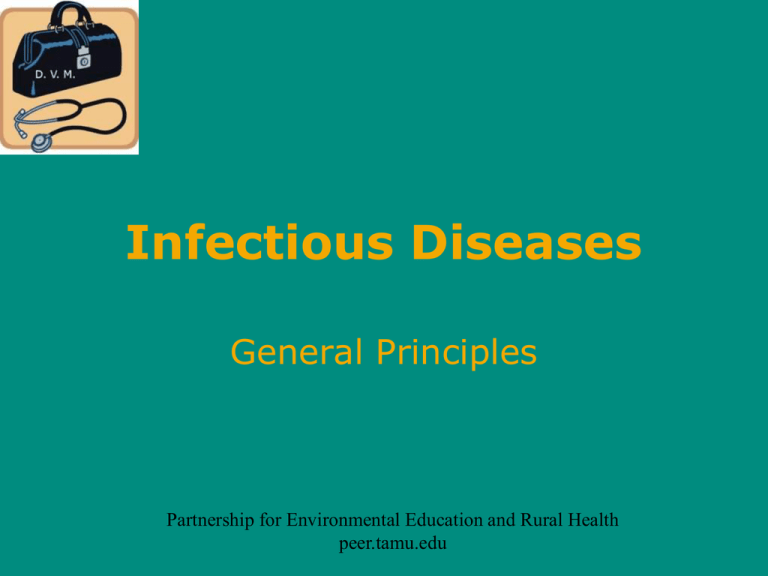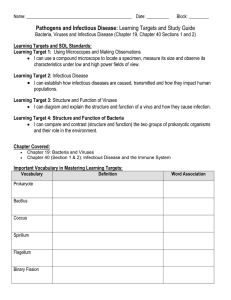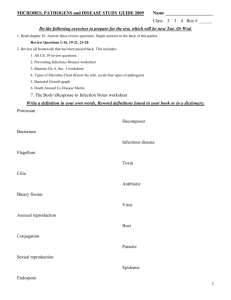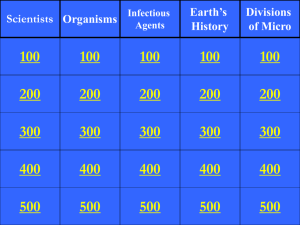Combating Infections
advertisement

Infectious Diseases General Principles Partnership for Environmental Education and Rural Health peer.tamu.edu Infectious Diseases are Caused by Microbes Vaccination can protect against some infections What is a Microbe? • Microbes are microscopic organisms that can live almost anywhere. Different microbes have different habitat preferences, ranging from extreme heat to extreme cold. Some microbes need oxygen and some do not. • Most microbes can survive in a large variety of habitats, but they can only thrive in a few habitats. • We even have microbes in our bodies-some help us out and some hurt us. You have to have a microscope to see microbes! Microbes Can Multiply Fast! - as long as the temperature is right and there are enough nutrients- Typical growth curve of an undisturbed population of microbes … at normal temperatures (about 40 – 100 degrees F) Can You Explain: Why growth becomes stationary? Why the microbes eventually die? Why this rapid growth does not occur at cold temperatures? …at very hot temperatures? Common Types of Microbes Viruses Bacteria Fungi Protozoa What Do They Look Like? Infectious agents look different, depending on what class of agent they are E. coli Source: NASA HIV Virus Source: NLM.gov Dutch Elm Fungus Campylobacter jejuni Source: AGRIC.gov Hepatitis C Virus Source: Amgen, Inc; NIH.gov Source: cfsan.fda.gov Ciliated Protozoa Source: blm.gov; Wilhelm Foissner Microbes and Disease • Some microbes cause disease and some don’t. Infectious agents are microbes that can cause disease. • Microbes that cause disease are called infectious agents, commonly called “germs” or “bugs.” Bacteria Bacteria can look like balls, rods, or spirals. Source: NSF.gov • Bacteria are unicellular and prokaryotic • They have their own metabolism. • There are countless numbers of bacteria on the Earth but less than 1% of them cause disease in humans. • Bacteria can live in a vast range of places, but need energy sources to thrive. • Some bacteria produce toxins that can harm us. Definitions • Unicellular - one-celled organism, self-contained inside a membrane. • Prokaryotic - organisms that lack a nucleus or any membrane-bound organelles. • Metabolism - chemical reactions that help living things stay alive ... typically involve breaking down compounds or building up structures or secretions. • Toxin - a chemical made by an organism that makes another organism or animal sick. Prions • A prion is an infectious particle made from an abnormally folded protein found on the surfaces of neurons. • Prions are highly resistant to heat, UV radiation, and disinfectants. • The best known prion forms holes in brain tissue, making the brain look like Swiss cheese. The prion causes mad-cow disease. Viruses • A virus is a microbe that consists of a nucleic acid housed within a protective coat. • The virus reproduces by hijacking the host cell’s metabolic machinery to replicate its own DNA or RNA. • Most viruses cause disease and are specific as to which type of cell they will attack. Source: niaid.nih.gov Protozoa • One celled microbes that can be parasites or predators of other microbes. • Can live in a variety of places, but prefer moist habitats. • Usually cause disease in humans. • Protozoa are sometimes helpful to other animals (food source for whales and help cows as well as termites digest their food! Protozoa found in human stool samples Source: CDC.gov Fungi • A multi-cellular microbe that is much larger than the other microbes. • Only about 1/2 of all fungi causes disease in humans. • Yeast is a fungus that is used to make bread and cheese for us! Review Question #1 1. What is a microbe? 2. Name some kinds of microbes. 3. Describe a typical microbial growth curve. 4. Why can some microbes live in hot temperature, while most cannot? How Can an Infectious Agent Attack Me? • Infectious agents can enter through air, food, water, sexual interactions, skin contact, blood transfusions, etc. • The body’s reaction to an infection can vary from a mild discomfort to death. Infectious Agent For more on the immune system, click here Species Specificity I can transmit Brucellosis and Tapeworm We can transmit lots of infectious agents including arena viruses and hantavirus. I can transmit Ebola virus! • Some infectious diseases of animals can be transferred to humans. • These are called zoonotic diseases. • All mammals can transmit rabies but raccoons and skunks are the most common carriers. Where Do Infectious Agents Hide When Not Infecting You? • Bacteria, protozoa, and fungi all reside in the soil. • Other infectious agents can live on surfaces for hours or even days, like the cold virus. Infectious Agent Life Cycle • Once a few microbes enter the body, it may take a few hours or days for the agent to reproduce enough to become infectious to others or to cause disease. Do you know the difference between “infectious” and “contagious?” Infectious: microbe can invade the body Contagious: microbe can be spread from one person to another. Review Question #2 1. How can microbes get in the body to cause infection? 2. Name some diseases that illustrate relative species specificity …. Name some that do not. 3. What’s the difference between being infected and being communicable? What are the Main Types of Infectious Disease? Food Poisoning Respiratory Diseases Liver Diseases Sexually Transmitted Diseases Food Poisoning is a Disease Caused by Infectious Agents Prevent food poisoning by stopping microbes from reproducing: keep hot foods hot and cold foods cold. Food Poisoning • Botulism- collapse, respiratory failure, and death. (Caused by improper canning methods) • Classical food poisoning can be prevented by better food storage and handling techniques. • Outbreaks usually occur at picnics, school cafeterias, or anywhere where the food is not handled properly or not kept refrigerated. Symptoms • nausea • vomiting • abdominal cramps • fever • diarrhea • See also our curriculum on the Digestive System Which Foods Are a Problem? • Almost ALL foods can carry infectious agents. • Hamburgers, potato salad, cold cuts, hot dogs, soft cheeses, eggs, and any raw meat are favorite places where microbes can grow and become likely to infect. Respiratory Diseases • Many infectious agents attack the respiratory tract. • The most common respiratory disease is the cold, but others include bronchitis, influenza, SARS, and pneumonia. See our Web curriculum on respiration Infectious Agents Can Be Deadly • Infectious diseases cause more deaths worldwide than any other single cause. • Infectious diseases account for over 56% of deaths in developing countries. • However, these diseases account for only 8% of deaths in rich countries. Liver Diseases • Most liver diseases are caused by a variety of viruses. Best known are hepatitis A, B, C. • These viruses cause hepatitis (inflammation of the liver) • You were probably vaccinated for Hepatitis A virus when you were young. Source: consensus.nih.gov A liver with varying stages of hepatitis. The cells on the left are normal liver cells. Sexually Transmitted Diseases • STD’s are a result of various viral and bacterial infections that are transmitted through sexual interaction or blood/serum exchange. • There are more than 20 STD’s identified. • The most common are: Microbe Disease Chlamydia Chlamydia trachomatis Syphilis Treponema pallidum AIDS HIV Herpes Herpes Simplex Virus Acne is an Infectious Disease! Acne is not contagious, but it is infectious • The pimples are dead white blood cells that were attacking bacteria in the skin’s pores. • The sebaceous glands in your skin make an oily substance called sebum. Too much sebum can clog up the hair follicle. This allows bacteria to grow and multiply. • White blood cells rush to fight the infection. Different infectious diseases require different approaches for prevention and control. But for any disease, there are three key steps for dealing with it. Three Key Steps Break the cycle of transmission ill the infectious agent ncrease host resistance Review Question #3 1. List common types of infectious disease. 2. Name a common infectious disease that affects the intestines … the lungs … the liver … sex organs … the skin. 3. What are the three key steps for dealing with infectious disease? Activity Time Demo on spread of disease. Some Current Research 1. Over-use of antibiotics has led to some bacteria developing resistance. It’s a big problem. 2. Scientists search for antibiotics that can replace current ones to which bacteria have evolved resistance. In the old days, scientists took soil samples to find fungi that killed bacteria One New Strategy Forcing antibiotics to grow with another kind of bacterium might cause them to start secreting an antibiotic to kill off the competition. Many bacteria have genes that can make products, like toxins —even antibiotics against other bacteria.









